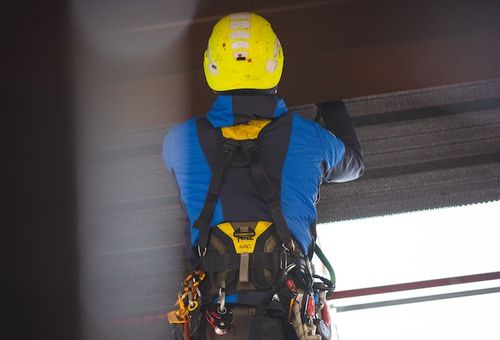Best rope access specialists in Klipspruit 298-Iq, Gauteng
Top rope access specialists near you
Browse the best rope access experts and compare ratings and reviews.
Hire the best rope access specialist
Search Uptasker for the best rope access specialists - compare ratings and read reviews
Why would one use Rope Access?
Let’s first explore the concept of rope access, also known as industrial climbing or commercial climbing. Rope access is an adaptable and efficient way of reaching difficult-to-reach places using ropes, harnesses, and allied climbing equipment. It is a form of non-powered top-anchored work positioning, which relies on a two-rope full-body or sit harness system for the worker to be able to safely access difficult-to-reach areas or to manoeuvre around obstacles. Each of these ropes is anchored in two suitable positions, thus negating any danger of the worker falling if the anchor system fails. There is the primary load-bearing rope which allows for progressive movement (either ascending, descending (vertical), or moving across a structure (horizontal/diagonal)). The second rope acts as a safety rope and is primarily a backup system which offers an additional safety feature. However, it should be noted that rope access is used mainly for working from the top down, as ascending using this system is more difficult. Fernand Petzl, a French caver, developed a mechanical rope ascender in 1968, and both handled and handleless ascenders are available, but these are used mainly by mountaineers and cavers.
Rope Access vs traditional fixed access methods
Being versatile, faster, less costly, safer, more flexible, and easily transportable, rope access is often used in construction, repair, inspection, and maintenance work where traditional methods are not possible. Whilst it has advantages over the more rigid scaffolding access methods, mobile elevated work platforms or aerial work platforms, etc., (known generally as “cherry pickers”) or dangerously long ladders, it also comes with its own set of disadvantages, including being more dangerous in some situations, particularly if the proper safety equipment is not utilised and correct safety procedures followed. It is also difficult to transport heavy loads upwards or downwards using this method.
Further advantages of rope access
Because rope access is quicker to install and dismantle than bulky scaffolding platforms and cranes, and there is no need for large items of equipment and vehicles to be transported to the site, there is less inconvenience and cost involved.
Scaffolding or cranes necessarily have to be left on site for the duration of the job being undertaken, which can not only be a blot on the surrounding area, but also cause inconvenience to those below as entrances and areas immediately around the scaffolding may have to be blocked completely or cordoned off, whereas rope access is dismantled at the end of each day. The erection of scaffolding and placement of cranes requires permits and sometimes clearing of sections of the site for reasons of access, which can result in costly delays and possibly intrusion into surrounding properties or businesses. Rope access in confined spaces is an invaluable asset when it comes to the cleaning, inspection and maintenance of structures such as industrial chimneys, wind turbines, towers, silo tunnels, and bridge pillars, simply because traditional scaffolding design and platforms are extremely limited in accessing such structures. Because rope access systems are so quick to install, it follows that both time and staffing requirements are minimalised as a result.
Is there a demand for rope access services?
The construction, civil engineering, and oil and gas industries all make use of rope access services. On smaller jobs or in tight or difficult-to reach spaces, rope access teams are in high demand. Such teams can be confined to smaller or larger numbers, depending on the job and the space allowances. Nonetheless, for safety purposes, there should be a minimum of two people working together, to allow for rapid rescue in the case of an emergency.
How to find the right rope access specialist
When searching for highly specialised industries such as these, check their online ratings and customer reviews, which can easily be done through search sites such as Uptasker, which also provides online ratings. Uptasker lists in geographical locations, as well as providing ‘one-click’ links to websites, if available, from which you will be able to see their catalogues or pictures of their previous work, which will give you an immediate indication of their experience in various applications. Building and construction magazines will also list these specialists, as this is their main area of work. The online Yellow Pages or other search engines are also useful, but Uptasker will provide all required information under one category heading, which is a time-saving bonus.
Top rope access specialist tips

Rope access technicians/companies are highly trained specialists in their field. Their expertise definitely has a place in modern inspection, repair, maintenance, and construction spheres, due to their speed of access, ability to manoeuvre in tight spaces, lack of need for bulky construction equipment, and safety record. They offer a viable and economically advantageous solution in areas where bulkier methods of access are either extremely difficult, time-consuming and or not optional alternatives.
Read Rope Access articles



